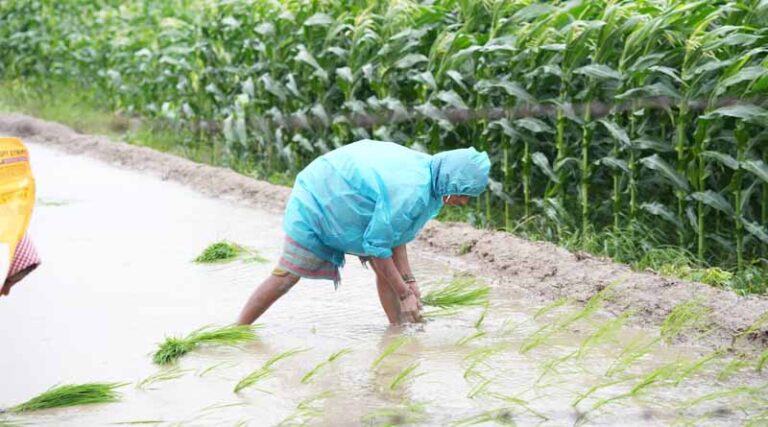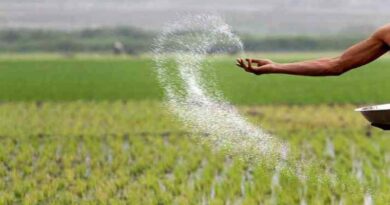
India’s Foodgrain Output Hits Record 353.96 MMT in 2024–25, Up by 21.66 MMT from Last Year
30 May 2025, New Delhi: India’s agriculture sector has once again proven its resilience and momentum, registering historic highs in the production of foodgrains and several key crops in the agricultural year 2024–25. According to the Third Advance Estimates released by the Ministry of Agriculture & Farmers’ Welfare, the total foodgrain production is pegged at 3539.59 Lakh Metric Tonnes (LMT), up from 3322.98 LMT in 2023–24. This impressive jump of 216.61 LMTmarks a 6.5% annual increase, driven by favorable climatic conditions, improved agri-infrastructure, and progressive policy support.
Union Minister Shri Shivraj Singh Chouhan attributed this significant progress to the visionary leadership of Prime Minister Narendra Modi, asserting that “farmer-centric initiatives, adoption of advanced agri-technologies, and timely reforms” have laid the foundation for this robust growth.
A Season of Records: Rice, Wheat, Maize Lead the Charge
Among the most notable developments is the record production of rice, wheat, and maize, which serve as the backbone of India’s food security. Rice production touched 1490.74 LMT, an increase of 112.49 LMT over last year’s 1378.25 LMT, reflecting an 8.16% growth. Wheat, another critical rabi crop, saw a rise from 1132.92 LMT to 1175.07 LMT, adding 42.15 LMT, a 3.72% increase.
Maize, often considered a barometer of balanced grain diversity, achieved a record 422.81 LMT, marking a gain of 30.66 LMT over the previous year’s 392.15 LMT. This signifies a 7.82% growth, reflecting how India is diversifying cereal production with equal strength.
Crop-Wise Comparative Analysis: Growth Over Last Year
The table below illustrates the production figures for 2024–25 versus 2023–24 and highlights both absolute growth in LMT and the percentage change:
| Crop | 2023–24 (LMT) | 2024–25 (LMT) | Growth (LMT) | Growth (%) |
|---|---|---|---|---|
| Total Foodgrains | 3322.98 | 3539.59 | 216.61 | 6.52% |
| Rice | 1378.25 | 1490.74 | 112.49 | 8.16% |
| Wheat | 1132.92 | 1175.07 | 42.15 | 3.72% |
| Maize | 392.15 | 422.81 | 30.66 | 7.82% |
| Shree Anna | 175.72 | 180.15 | 4.43 | 2.52% |
| Nutri/Coarse Cereals | 569.36 | 621.40 | 52.04 | 9.14% |
| Pulses (Total) | 242.46 | 252.38 | 9.92 | 4.09% |
| Moong | 31.03 | 38.19 | 7.16 | 23.07% |
| Tur | 34.17 | 35.61 | 1.44 | 4.21% |
| Oilseeds (Total) | 396.69 | 426.09 | 29.40 | 7.41% |
| Groundnut | 101.80 | 118.96 | 17.16 | 16.85% |
| Soybean | 130.62 | 151.80 | 21.18 | 16.22% |
| Rapeseed & Mustard | 126.00 | 126.06 | 0.06 | 0.05% |
| Sugarcane | 4501.00 | 4501.16 | 0.16 | 0.0035% |
| Cotton (Lakh Bales) | 336.30 | 306.92 | -29.38 | -8.74% |
| Jute (Lakh Bales) | 85.00 | 84.33 | -0.67 | -0.79% |
Note: Cotton and Jute are measured in lakh bales (Cotton – 170 kg each, Jute – 180 kg each)
Groundnut and Soybean Shine in Oilseed Segment
India’s total oilseed production surged to 426.09 LMT, reflecting a 7.41% increase from the previous year. The stars of this category were groundnut and soybean, which reached 118.96 LMT and 151.80 LMT respectively. Groundnut production rose by 17.16 LMT (16.85%) while soybean gained 21.18 LMT (16.22%).
This remarkable jump indicates the growing demand and policy push towards edible oil self-reliance. It also reflects the effective utilization of agronomic practices, seed quality enhancement, and appropriate MSP (Minimum Support Price) signals influencing farmer choices.
Pulses Register Stable Growth, With Moong Stealing the Show
The total pulses production reached 252.38 LMT, improving over last year’s 242.46 LMT. Among individual pulses, moong (green gram) was the best performer with a 23% growth, climbing from 31.03 LMT to 38.19 LMT, a rise of 7.16 LMT.
Tur (pigeon pea), despite being an essential rabi pulse, showed modest growth from 34.17 LMT to 35.61 LMT, only 1.44 LMT, or 4.21%. While overall pulse growth is satisfactory, the uneven jump among varieties points to underlying supply chain and cultivation challenges that may need future policy intervention.
Least Growth and Areas of Concern
Despite the overall jubilant picture, not all crops saw significant improvement. Rapeseed & mustard production remained virtually stagnant, rising by just 0.06 LMT, a negligible 0.05% growth. Likewise, sugarcane, which already occupies an overwhelming production share, increased by a mere 0.16 LMT, virtually flatlining with only 0.0035% growth. This plateau may signal a need for diversification in high-water-use crops or could reflect saturation in productivity.
Most notably, cotton registered a decline of 8.74%, falling from 336.30 lakh bales to 306.92 lakh bales—a drop of 29.38 lakh bales. This could be attributed to factors like pink bollworm infestations, unseasonal rains, or reduced acreage. Jute also saw a slight dip of 0.79%, though the impact here is relatively minor.
Factors Behind the Surge
This bumper crop output can be largely attributed to timely and well-distributed monsoon rainfall across key agro-climatic zones. Improved soil moisture levels created ideal sowing conditions during both kharif and rabi seasons. The government’s focus on irrigation projects, distribution of quality seeds, and push for climate-resilient farming also played an important role.
Digital outreach through Krishi Vigyan Kendras, PM-Kisan Samman Nidhi, and aggressive implementation of crop insurance schemes contributed to both increased farmer confidence and higher productivity.
Sustainability in Focus
While these production records are commendable, experts caution that sustainability must now be the focus. For instance, the over-reliance on water-intensive crops like sugarcane and rice in water-scarce regions must be balanced with strategic crop planning. Similarly, ensuring MSP alignment with actual input costs, improving procurement in pulses and oilseeds, and incentivizing climate-resilient crop varieties will be essential.
The decline in cotton production must also be viewed with seriousness. Cotton supports millions of livelihoods, and any further drop may affect employment and export revenue. Integrated pest and disease management, along with enhanced seed quality, must be prioritized here.
Also Read: Insecticides India Limited (IIL) Launches New Herbicide Altair for Paddy Farmers in India
📢 Reach Farmers, Share Your Story, and Grow Your Brand!
Got news to share? A company story to highlight? Looking to launch an impactful advertising campaign? Connect with us at info@krishakjagat.org or nimishgangrade@krishakjagat.org and make your mark!
📢 Connect with 100+ Million Farmers! India’s leading farmers rely on Krishak Jagat’s Hindi website for trusted agriculture news, advisory and insights. Click here to explore!






